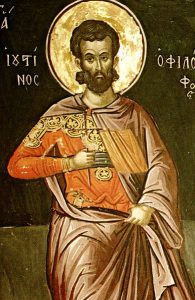
Sleepy me forgot to include the main thought that led to the argument of the previous post. Reflecting on Hägg’s point about the Life of Aesop being produced at a time when interest in Aesop was the fashion of the day, the question I was asking myself was:
- When do we see an interest in the pre-crucifixion earthly life-events of Jesus emerge in the record? When does that particular literary vogue begin?
Now that’s less subtle than an argument based on Paul’s influence on the Gospel of Mark.
The second century Pastoral epistle 1 Timothy speaks of Jesus testifying before Pilate.
Ignatius is among the earliest witnesses to an interest in biographical details of Jesus with his specifications of Mary’s pregnancy and Pilate’s role in the crucifixion. Though Ignatius’s martyrdom (and letter writing date) is said by Eusebius to be in the tenth year of Trajan (108 CE), we have reasons to think that the letters may really have been composed considerably later. As Roger Parvus writes:
Eusebius, in the fourth century, was the first to claim that the letters were written in the reign of Trajan (98 – 117 CE). A number of scholars have recognized that his dating is untrustworthy, and that the letters should be dated later. To give some recent examples:
- Allen Brent says “we can…, if we like, place Ignatius’ work towards the end of Hadrian’s reign (AD 135)” (p. 318 of his 2006 book Ignatius of Antioch and the Second Sophistic.
- And Paul Foster, in his chapter on Ignatians in The Writings of the Apostolic Fathers (2007), placed their composition “sometime during the second quarter of the second century, i.e. 125 – 50 CE, roughly corresponding to Hadrian’s reign or the earlier part of Antoninus Pius’ period in office” (p. 89).
- Timothy Barnes, in a 2008 article in The Expository Times (“The Date of Ignatius”), concluded that the letters were written “probably in the 140s” (p. 128).
- And Richard Pervo, in his The Making of Paul published in 2010 says “A date of c. 130 – 140 is the preferable date for Ignatius” (p. 135).
- Earl Doherty too, in his Jesus: Neither God Nor Man, does not have a problem with dating the letters to the third decade of the second century. (p. 296).
Justin Martyr of the mid-second century, discussed in the previous post, is also the earliest of the Church Fathers to show a detailed interest in writing about events in the earthly life of Jesus. Most of his discussion is an attempt to prove that the Old Testament writings were prophesying cryptically about Jesus. Again, see the table I have posted on vridar.info.
Interestingly the literary focus on the life of Jesus first appears to gain wider traction around the same time as the interest in and heated controversy over Paul.
Sure we can date the gospels to the last decades of the first century, but by doing so we have to wait some decades (and Justin does not even appear to know any of the gospels in their final canonical form) before we find anyone appearing to take any notice of their contents or sharing their interest in Jesus’ life.
Justin is said to be the first witness to the existence of the gospels but we need to keep in mind that Justin also said that fire (presumably a spiritual fire) engulfed the Jordan when Jesus was baptized, that the infant Jesus was found in a cave, that Pilate conspired with the Jews to crucify Jesus, and indicates that he had no concept of any Judas character or betrayal of Jesus by a disciple.
Is it not interesting that “the church”, or at least the “proto-orthodox” side of Christianity, first appears to take an interest in writings about the earthly life of Jesus at the same time as heated arguments over the teachings of Paul?
The two interests, the teachings of Paul and the earthly life of Jesus, first appear in the wider record around the same time.
Justin, as we saw in the previous post, is certainly one of the more hostile of the “fathers” towards Paul and he it is who is the first to show a strong interest, most unlike Paul, in interpreting the Old Testament as a string of prophecies about the earthly Jesus.
I don’t think the Gospel of Mark was originally written as a literal testimony to the pre-crucifixion life of Jesus, though. The narrative is far too patently (in my view) symbolic to think that it was written with a mind to be read literally. The author does not attempt to proof-text his narrative in the same way the author of the Gospel of Matthew did by saying “Jesus did or said such and such so that the scripture might be fulfilled.” (The only exception in English translations of Mark is in fact a gloss.) The Gospel of Mark was actually first associated with heretics (as was Paul) — with the followers of Basilides — though I suspect that Basilides’ followers knew of a kind of ur-Mark, not the form of the gospel we have today in our orthodox canons.
It is the Gospel of Matthew who is closest to the sort of narrative of Jesus that so engrossed Justin. Another point I find interesting is that the Gospel of Matthew, with its anti-Paul message and its focus on Jesus fulfilling passages in the OT, that was the most influential gospel in the second century while the Gospel of Mark was scarcely noticed among the proto-orthodox.
The point is that the mainstream view holds that the gospels were written between 70 and 90 and then forgotten or largely ignored until the mid second century.
Why not prefer to date them to a time when we find there was a more general interest in the sorts of things they write about?

